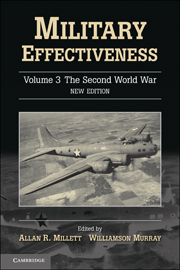Book contents
- Frontmatter
- Contents
- List of Contributors
- Introduction: Military Effectiveness Twenty Years After
- Maps
- 1 The Effectiveness of the Japanese Military Establishment in the Second World War
- 2 The United States Armed Forces in the Second World War
- 3 British Military Effectiveness in the Second World War
- 4 The Italian Armed Forces, 1940–3
- 5 The Dynamics of Volksgemeinschaft: The Effectiveness of the German Military Establishment in the Second World War
- 6 Bitter Victory: French Military Effectiveness during the Second World War
- 7 The Soviet Armed Forces in the Great Patriotic War, 1941–5
- 8 Military Effectiveness in the Second World War
- 9 Challenge and Response at the Operation and Tactical Levels, 1914–45
- 10 The Political and Strategic Dimensions of Military Effectiveness
- Index
1 - The Effectiveness of the Japanese Military Establishment in the Second World War
Published online by Cambridge University Press: 05 June 2012
- Frontmatter
- Contents
- List of Contributors
- Introduction: Military Effectiveness Twenty Years After
- Maps
- 1 The Effectiveness of the Japanese Military Establishment in the Second World War
- 2 The United States Armed Forces in the Second World War
- 3 British Military Effectiveness in the Second World War
- 4 The Italian Armed Forces, 1940–3
- 5 The Dynamics of Volksgemeinschaft: The Effectiveness of the German Military Establishment in the Second World War
- 6 Bitter Victory: French Military Effectiveness during the Second World War
- 7 The Soviet Armed Forces in the Great Patriotic War, 1941–5
- 8 Military Effectiveness in the Second World War
- 9 Challenge and Response at the Operation and Tactical Levels, 1914–45
- 10 The Political and Strategic Dimensions of Military Effectiveness
- Index
Summary
Introduction
Although the Second World War began years earlier for Imperial Japan than it did for the European powers or the United States, the West was dismally ignorant, in civilian as well as military circles, of Japan's military proficiency on the eve of the Pacific War. Partly, this was due to Japan's own siege mentality and exclusionist tradition, evidenced by its strict prewar policy of limiting foreign observation of its armed forces and by its conduct of tight police surveillance of residents and travelers. What might have been seen or read about was further veiled by the difficulty of the Japanese ideographic language and, in the case of the United States, by the Americans' modest investment in personnel assigned to Japan as language officers, attachés, or exchange officers. In the twenty-two years between 1920 and 1941, for example, the US Army assigned seven attachés and forty-two language officers to Tokyo. Only one of the language officers (Rufus Bratton, 1922–6) ever became an attaché in Japan (1933–7). Sidney Mashbir, a language officer in 1922–4, was able to put his skills to good use during and after the Second World War. In overall terms, US military intelligence personnel were very few in number in 1941, and most were engaged in ‘human source intelligence.’ It has been estimated that ‘less than a dozen U.S. Army and Navy intelligence officers were qualified to make a credible estimate of enemy capability based upon what little information did arrive.’
- Type
- Chapter
- Information
- Military Effectiveness , pp. 1 - 44Publisher: Cambridge University PressPrint publication year: 2010
- 1
- Cited by



